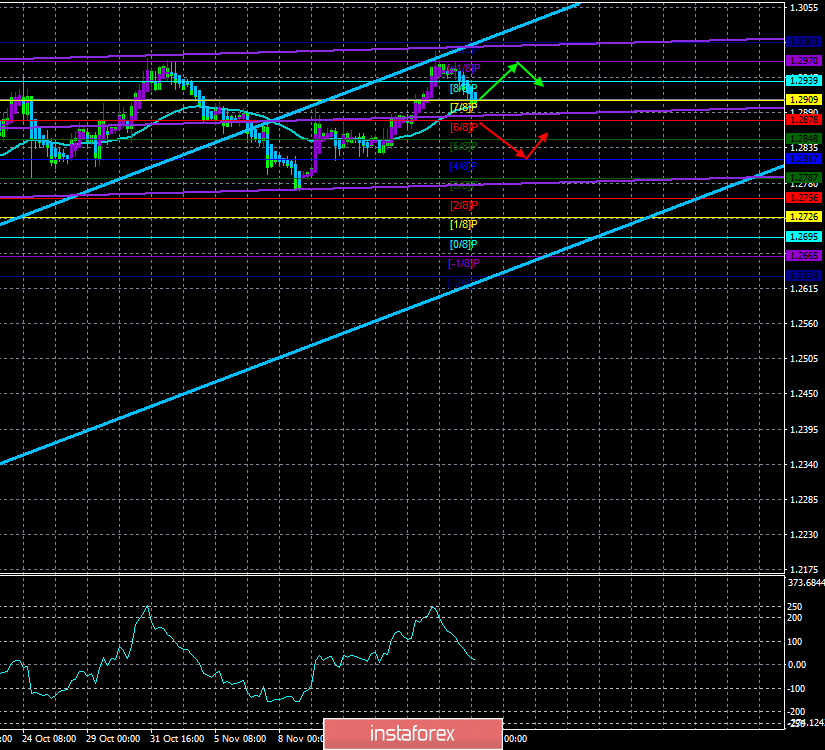4-hour timeframe

Technical data:
The upper channel of linear regression: direction – up.
The lower channel of linear regression: direction – up.
The moving average (20; smoothed) – sideways.
CCI: 17.0369
The British pound yesterday fell to the moving average line, failing to overcome the Murray level of "+1/8" - 1.2970. We have already said that it will be quite difficult for traders to overcome the area of 1.2970-1.3010, as there are no fundamental reasons for this, and the pound, from our point of view, has soared up quite strongly. Thus, yesterday's pullback may be the beginning of a new downward trend, although again it is unlikely to be strong, since there is also little fundamental data supporting the US dollar, and this week there are almost no important macroeconomic publications. Nevertheless, the British currency still has a formal chance of continuing to strengthen. Both channels of linear regression are directed upwards, and the price continues to be located above the moving average.
We have previously said that there is no single opinion on the issue of Brexit either among British politicians or among the British population. This is evidenced by a whole bunch of different facts and events – starting with the referendum in 2016, in which the preponderance of those in favor of leaving the EU was about 4%, and ending with yesterday's debate between Boris Johnson and Jeremy Corbyn. It is at the last event that we would like to dwell in more detail. The debate was built around domestic political topics such as medicine, education, security, migration policy, and, of course, Brexit. However, according to almost all viewers of this show, nothing fundamentally new policy was reported. Each of the leaders of his party simply stood his ground. Johnson touted his agreement with the European Union, Corbyn said that this agreement is even worse than the one that was reached by Theresa May. At the end of the debate, viewers were asked to rate the performance of each politician and cast their votes in favor of one or the other. It turned out that 51% voted for Boris Johnson and 49% for Jeremy Corbyn. Thus, formally, Johnson won, but this victory is the same as the results of the referendum – ambiguous. The results of the debate are mixed, even on different topics. For example, 63% of viewers think Johnson did well on the topic of Brexit, while 54% of viewers think Corbyn was better on the topic of health care. The Labor leader was praised for his attitude towards ordinary people, and Johnson was considered more suitable for the post of Prime Minister. As we can see, there was no consensus either. And this still means that the election results can be completely unpredictable.
Yesterday's decline in the pound is a good bell for traders, but not for the pound. If traders' optimism about a conservative victory and Brexit in January 2020 fades, it could mean that the British currency will again be tipped to fall against the US dollar. Yesterday, we saw what all the ratings of support for a political party are worth. In televised debates, the balance of power between the main opposing forces was almost 50/50. Thus, we continue to believe that the victory of the conservatives in the parliamentary elections is by no means obvious, and the pound can return to a downward trend at any time.
From a technical point of view, the pound/dollar pair fell to the moving average, and today, in theory, the further fate of the pair will be decided at least for a few days ahead. If traders manage to overcome the moving average line, the downward movement will continue, although volatility now, in any case, remains very low and continues to fall. The rebound from the moving is a resumption of upward movement, which is also unlikely to be strong.
Nearest support levels:
S1 – 1.2939
S2 – 1.2909
S3 – 1.2878
Nearest resistance levels:
R1 – 1.2970
R2 – 1.3000
Trading recommendations:
The GBP/USD currency pair started to adjust against the weak upward trend. Given the fact that traders are now almost unresponsive to fundamental data, and important economic publications in the UK and the US are not scheduled for this week, the volatility is unlikely to grow today, the pound/dollar pair may well return to the flat. Also, there is a high probability of a reversal around the area of 1.2970-1.3010. It will be possible to sell the pair in case of consolidation below the moving average, but with minimal volumes.
In addition to the technical picture, fundamental data and the time of their release should also be taken into account.
Explanation of the illustrations:
The upper channel of linear regression – the blue line of the unidirectional movement.
The lower channel of linear regression – the purple line of the unidirectional movement.
CCI – the blue line in the regression window of the indicator.
The moving average (20; smoothed) – the blue line on the price chart.
Support and resistance – the red horizontal lines.
Heiken Ashi – an indicator that colors bars in blue or purple.
Possible variants of the price movement:
Red and green arrows.





















